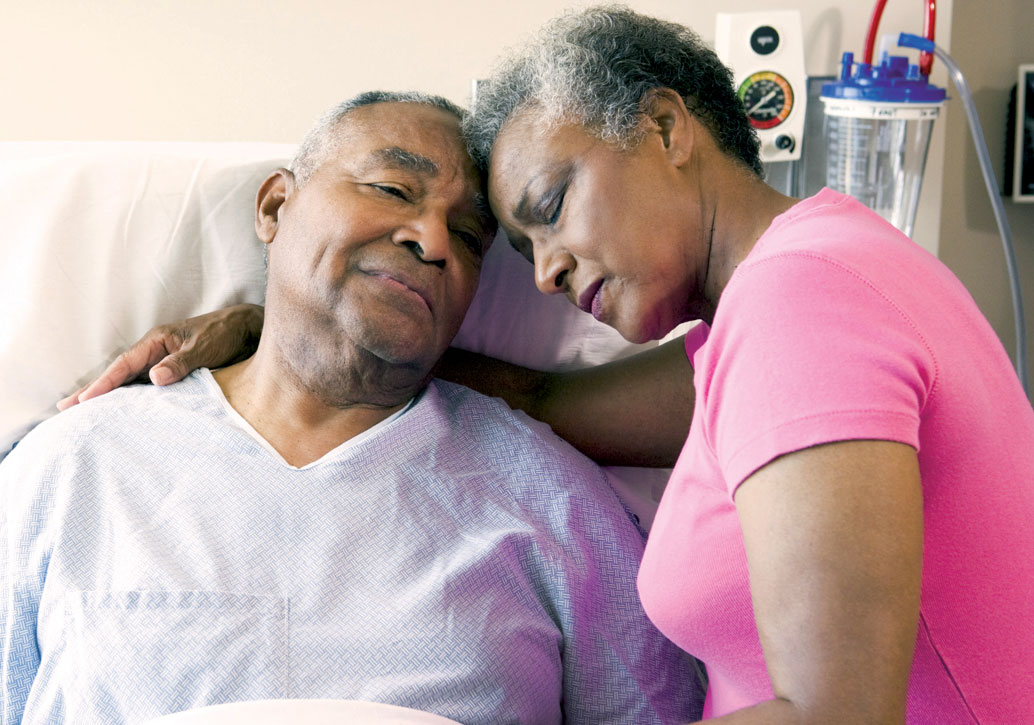Best practice in end-of-life care
By Andrea Prentice, BComm
In fall 2013, the Southampton Care Centre, a Jarlette Health Services long term care home, was surveyed by the Commission on Accreditation of Rehabilitation Facilities (CARF). The results were great. In addition to being awarded three-year accreditation, the Southampton Care Centre received the prestigious “exemplary conformance” designation for its palliative care and pain management programs. In 2013 both the Pain Management Committee and the Palliative Care Committee made significant gains in improving quality of life for residents and their families.
Deanna Crowe, Co-DOC and Education Coordinator at the Southampton Care Centre, explains: “Although the Pain Management Committee is not new at the Southampton Care Centre, we have been working very diligently over the last year at improving residents’ quality of life and pain relief with respect to responsive behaviours, mobility, sleep, participation in activities, skin care and, of course, in end-of-life care.”
Pain management
The Pain Management Committee meets monthly and is made up of multidisciplinary members. Residents who are in need of enhanced pain relief are identified in a variety of ways: through daily report and the Minimum Data Set if they trigger an alert for pain or worsening pain; through staff or family queries or concerns; and through other committee referrals such as for responsive behaviours, falls prevention, and skin and wound care.
The Committee reviews information from several sources, including the resident’s medications (in particular as-needed use), their physiotherapy program and pressure-relief-surface options, any responsive behaviours and patterning (with the use of an aggressive behaviour scale), activity participation rates and interests, the presence of depression (using a depression rating scale), bowel-movement tracking and, of course, pain-assessment results. These data are combined with input from residents, families, staff, pharmacy staff, physicians, occupational therapists, physiotherapists and chaplin services.
After the review, registered staff complete a pain assessment three times a day for seven days or use the Pain Assessment in Advanced Dementia Scale (PAINAD) for residents who are unable to communicate, with the results forwarded to a physician. Concurrently, behaviour mapping is put in place for five days. Referrals are then made as required to pharmacists, dieticians, physiotherapists, occupational therapists, and activation and spiritual care staff.
The process is working. In February 2013, 6.5% of residents were identified as having pain and 14.5% as having worsening pain. The following year, these numbers had dropped to just 2.5% and 13.2% of residents, respectively.
 The work of the Pain Management Committee has significantly contributed to improving end-of-life care. Simultaneously in 2013, another quality improvement project, this one managed by the Palliative Care Committee, was underway. The focus of this project was extended not just to the comfort of palliative residents, but also to that of family members.
The work of the Pain Management Committee has significantly contributed to improving end-of-life care. Simultaneously in 2013, another quality improvement project, this one managed by the Palliative Care Committee, was underway. The focus of this project was extended not just to the comfort of palliative residents, but also to that of family members.
Palliative care program improvements
As a result of the experience of a former resident’s family member, the management of the Southampton Care Centre identified the need for improvements in the palliative care program. Around the same time, questions about palliative care were raised at a family council meeting.
Family members were asking, “Why is there no palliative care room?” “Doesn’t it bother residents to share a room with a dying room-mate?” “What about the families that are frequently visiting?”
This topic had come up many years ago, and the residents had voiced their opinions then. There was in fact a palliative care room when the home was first built 40 years ago, but it was not used; it sat empty. When the residents were polled, they said they would prefer to be made comfortable in the room that had become their home and not in a palliative care room, whether in the home or at hospital.
“We wondered if the current resident population felt the same now as they did then,” says Andrea Prentice, Resident and Family Services Coordinator. “So we conducted a survey with several cognitively aware residents and asked them the same questions.”
Here are some of their comments…
“Family members and residents want to say goodbye. It is a hard thing to lose someone. They need to spend time together and I would respect that. Maybe it would be uncomfortable for the family [to be in a shared room] but not for me. We are close to our room-mates. They have the curtain to pull if they want privacy. I know you can hear, but I would just pretend I wasn’t listening.”
Being in close proximity to a dying roommate or fellow resident allows other residents the opportunity to not fear death but to accept it. It doesn’t make me think of my own mortality, but that is because most of us deal with that before we come here. We spend our last time here and the people here, the residents and staff, become our friends and family. For someone to assume that it would bother us, they don’t live here, they don’t know.”
When asked if it made them uncomfortable if a room-mate was dying, one resident commented, “She must have been comforted knowing someone was there. It didn’t bother me at all. We all have to die sometime.” Another said, “I was happy for her that she had her family there with her. That is important and death shouldn’t be hidden.”
“We discovered that education was required for family members to help them understand that residents want to stay in their own room if they become gravely ill,” says Prentice. “We needed to help support families in the event that their loved one became palliative.”
The Palliative Care Committee—with input from the quality,
resident, family and spiritual councils, and the local funeral home—
developed several quality-improvement initiatives:
• expansion of the VON volunteer program (volunteers in this program have extensive palliative care training)
• a roster of staff members who are willing to sit with residents who do not have family
• obtaining consent for volunteer visiting upon admission
• improved communication with visiting community clergy and lay persons
• the use of a butterfly logo to identify palliative residents to staff and volunteers
• the continued use of a CD player and soothing music in palliative residents’ rooms
• placement of battery-operated candles for a calming atmosphere
• the addition of pictures on the memorial board when a resident has died
• reintroduction of the palliative care basket (designed more for families), with items to support families and help pass the time
The palliative care basket includes a notebook for family or friends to communicate between visits, books of inspirational thoughts, crossword puzzles and cards, tissues, gum, lozenges and, most importantly, the “When a loved one is dying” booklet.
The booklet contains valuable information for families, including what to expect during the dying process, information about how other residents feel about their room-mates dying and visiting family members, understanding what to do after death (e.g., who to notify) and information about the grieving process. This booklet was shared with the family and resident councils.
“The initiatives are being well received,” reports Prentice, “with several positive comments.”
Andy Levy expressed, “Now that it is over for Enid, I want to thank you and your staff for everything you did for my mother. Time and again, my family and I were struck by the patience and compassion shown by staff, not just to my mother, but to all SCC residents. You are to be commended for your humanity. Thank you for allowing my mother to exit with love and dignity.”
Larry Main said, “The palliative care package, the booklet and the music were very well received by my sister Linda and myself. We also told many other members of our family and friends and received nothing but complimentary comments in return. We highly recommend that you continue with the practice. We do not know how any family could take offence. We were also pleased to have the nurse who was on duty during that time recommend that Mom remain in the care of Southampton Care Centre rather than being transferred to hospital. It was a very warm and caring atmosphere compared with the hospital environment.”
A model for best practice
As a result of the praise from the CARF surveyors about the Southampton Care Centre’s palliative care and pain management programs, the company that owns the home, Jarlette Health Services, has opted to focus on palliative care as a corporate-wide quality improvement project in 2014. The successful initiatives put in place in the Southampton Care Centre in 2013 will be used as best practice at all Jarlette Health Services homes. Administrator Brenda Ohm puts it simply: “This family-run organization’s core purpose is to strive to make an outstanding difference in the lives of others. This philosophy extends to include the end-of-life journey.”
Andrea Prentice holds a Bachelor of Commerce from the University of Guelph and a Canadian Health Care Association Long Term Care Management Diploma. She has worked in the long term care industry for over close to 15 years, is a former long term care home Administrator and is the Resident and Family Services Co-ordinator at the Southampton Care Centre.













